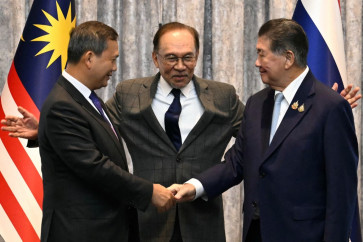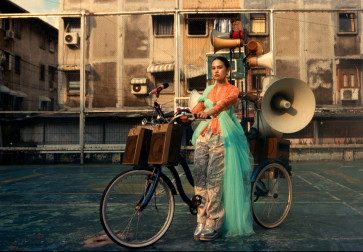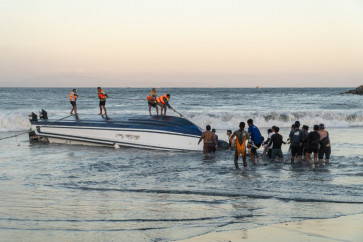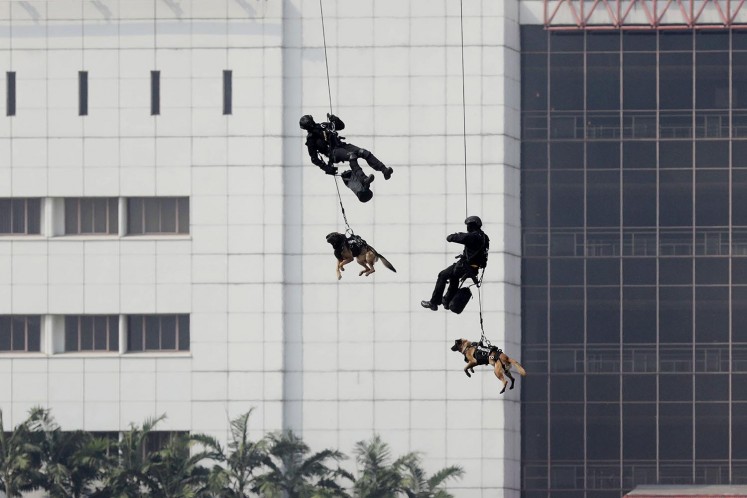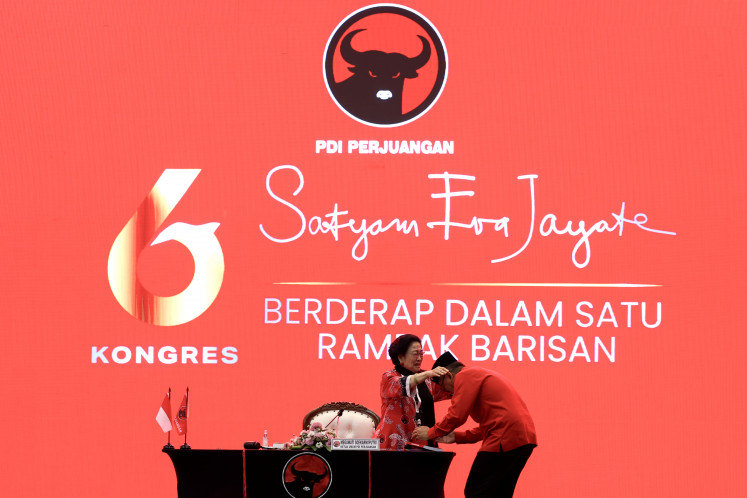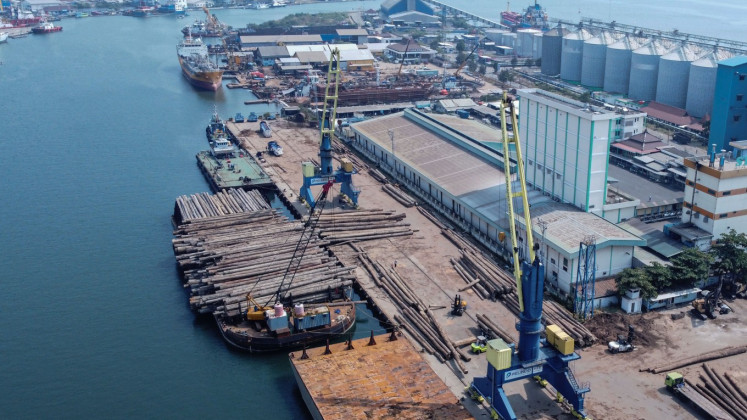Popular Reads
Top Results
Can't find what you're looking for?
View all search resultsPopular Reads
Top Results
Can't find what you're looking for?
View all search resultsThe tsunami that brought peace
Peace at last: Residents watch the broadcast from Helsinki, Finland, of the signing of the historic peace agreement of the Indonesian government and the Free Aceh Movement (GAM) on Aug
Change text size
Gift Premium Articles
to Anyone
P
span class="caption">Peace at last: Residents watch the broadcast from Helsinki, Finland, of the signing of the historic peace agreement of the Indonesian government and the Free Aceh Movement (GAM) on Aug. 15 2005, in front of the Baiturrahman Grand Mosque in Banda Aceh. JP/ R. Berto Wedhatama
At the foot of the hills in Pidie regency, on the morning of Sunday Dec. 26, 2004, soldiers fired a rocket at a Free Aceh Movement (GAM) encampment. The ground suddenly shook ' more violently than would have been expected from the rocket ' and was followed by silence.
Everyone soon understood what had happened. GAM militia were allowed to check on their families in the hardest-hit coastal areas, including the capital, Banda Aceh.
Former GAM defense minister Zakaria Saman received a call from Sweden. It was Malik Mahmud, GAM's foreign minister. 'We were told to stop fighting,' Zakaria said. The people were suffering and the villages that had supported GAM troops with food and money to purchase weapons had been wiped out. Military camps had also been swept out to sea, such as those in Lamlo, along with the civilian populations.
The National Police, then under Gen. Da'i Bachtiar, had offered a bounty of billions of rupiah for Zakaria's head, as his illegal entry into Indonesia had been detected. After 24 years in Sweden he had asked GAM leader Hasan Tiro for permission to return home; the GAM defense minister said he had felt responsible for the people following intensified military operations against GAM.
As chief security minister under former president Megawati Soekarnoputri, her successor, Susilo Bambang Yudhoyono, had been involved in earlier, failed negotiations and cease-fire attempts with GAM.
Negotiations had started in 2002 with the initiative of then chief minister for people's welfare Jusuf Kalla. The businessman, who later became Yudhoyono's vice president, had managed to limit the violence in both Poso, Central Sulawesi, and earlier in Maluku.
Kalla's top negotiator, Hamid Awaluddin, later law minister under Yudhoyono, writes of several meetings with GAM leaders in Jakarta, Makassar, the Netherlands, Malaysia, Denmark and Sweden.
One cease-fire brokered by the Geneva-based Henri Dunant Center and a few other organizations ended in the 2003 burning of the cease-fire committee office in East Aceh. This followed the traumatic arrest of six GAM negotiators in July 2001 after attending talks with Indonesian authorities in Banda Aceh ' 'just like the Dutch kidnapping of Diponegoro' on the pretense of inviting him for negotiations, Zakaria said, citing the fate of a leading prince fighting Dutch rulers in the late 1800s.
Days after the disaster, Hamid was summoned by Kalla to his residence. Kalla said the war must stop. 'What would happen if outsiders helping Acehnese were suddenly kidnapped or murdered?' said Kalla according to Hamid's memoir, Damai di Aceh (Peace in Aceh).
Kalla told Hamid and Sofyan Djalil, an Acehnese who was the information minister and now the coordinating economic minister, to step up efforts for a final negotiation. The main intermediates were Farid Hussein, one of Kalla's staff, and Juha Christensen, a parliament member in Helsinki who was interested in helping Aceh's peace process.
Before the meetings with GAM leaders, Kalla invited ambassadors from countries including those where GAM leaders had permanent residence and citizenship ' Sweden, Denmark, the Netherlands, Malaysia, Singapore and Libya, where they had trained. Japan and representatives of the EU, which was involved in cease-fire attempts, were also invited.
The main tools of negotiation Kalla gave to Hamid and Sofyan were two sheets of paper filled with diagrams that Hamid had come to recognize during negotiations in Maluku and Poso. The 'Helsinki MoU', as it is known, was signed on Aug. 15, 2005.
In early meetings some GAM delegates were 'highly cynical', Hamid said, given long gone trust in the central government. The government settled on the Helsinki-based Crisis Management Initiative (CMI) led by former Finnish president Martti Ahtisaari as the mediator. Yudhoyono and Kalla forged on, despite perceptions in Indonesia that GAM, referred to as a criminal and security disturbance group, was 'a domestic matter' and the Helsinki talks were 'informal' and thus the product would not be legally binding. This was the pervasive 'myth', said Hamid, as Aceh was already an international issue, more so with the natural calamity. The international community fully realized it could only help Aceh under the Jakarta government, Hamid noted.
Kalla and Yudhoyono kept encouraging their harassed negotiators to focus on Aceh's victims of the war and the disaster. 'Thank goodness SBY did not take Ryacudu' as the new military commander, said a GAM negotiator, Nur Djuli, as then Army chief of staff Ryamizard Ryacudu, now defense minister, was among the chief hawks opposing the peace talks. Clashes still broke out between government troops and GAM. Survivors said some soldiers still harassed residents, taking their aid items like tents and radios. 'Strangers from all countries came to help us but the TNI [Indonesian Military] still searched us, suspecting we were GAM,' one survivor said bitterly.
Farewell to arms: Government representative to the Aceh Monitoring Mission (AMM) Lt. Gen. (ret) Bambang Darmono displays a newly decommissioned weapon belonging to the Free Aceh Movement (GAM) in Banda Aceh on Dec. 21, 2005, witnessed by GAM representative Irwandi Jusuf (second from right) and AMM chief Pieter Feith (right). JP/R. Berto Wedhatama
Hamid cited the support of Gen. Endriartono Sutarto, then the TNI commander, who denied the TNI didn't want peace.
Amid threats that the talks would collapse, during each round 'people across Aceh prayed for us in meunasah [small mosques],' Nur Djuli said.
Zakaria recites, 'During all the rounds of the Helsinki talks I was in touch twice a day with the leaders in Sweden through satellite phone. [...] We finally agreed to self government, special autonomy within the unitary republic.' The EU sent Pieter Feith, later the head of the Aceh Monitoring Mission overseeing the MoU implementation, to the Pidie hills of Jiem-jiem Keumala by helicopter, with the volunteer Christensen to meet Zakaria. The delegates had to ensure the local GAM officials also agreed to the entire MoU, apart from their leaders in Helsinki.
In 2008, Ahtisaari accepted the Nobel Peace Prize.



